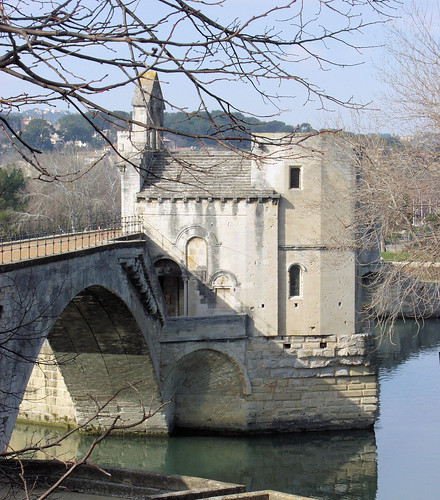A gorgeous day yesterday, too nice to be spent in museums, so I started out at the famous Pont Saint-Benezet, famous chiefly, I gather, for a rather irritating children’s song, which was anyway factually incorrect, since in the 19th century they danced under, rather than on, the bridge – probably safer. But still the 19th-century did save four spans of the rather remarkable structure. It was built in the 12th century – what was described as the “first bridge” – although archaeologists have found it had a Roman predecessor, and the medieval constructors used its foundations, at least in part.

But the Rhone was still a big challenge – and it was beaten – the legend says by a God-inspired shepherd boy of 11 who came down to the town and told the people to build the bridge, laying the first, impossibly large, foundation stone himself. That was of course Benezet – who is buried in the lower of these two chapels – well he was, until his body went on one of those inevitable medieval wandering courses.
That first bridge was pulled down by the nasty French, after the Avgnonaise, an early independent Republic under the suzerainty of the Count of Toulouse, were so unwise as to side with the Albigensians (believers in Manicheism). (The walls, and the merchants and nobles great defensive tower houses went too.) But the bridge soon went up again and continued in use until the 17th century.

But I couldn’t use it to cross the Rhone, so it was off to the modern bridge (soulless and dull and boasting a cycle lane about 15cm wide!) and over to what had been the French side of the border – past the Tower of Philip the Fair that he built at the other end of the bridge – a great soaring pinnacle of a statement.
The town of Villeneuve Lez Avignon now looks like a genteel commuter suburb of the city, fitting really since this was where many of the cardinals had their “country houses” – it still feels detached from real life. Although it does boast an odd-shaped church of Notre Dame. It probably began life as Cardinal Arnaud de Via’s private chapel, finished 1333,but he, of course wanted more, to preserve his fame. He was able to buy some houses to knock down, and furnished it thus with a nave.
He died and was buried in his church, but the plan not complete without a tower. Only one problem – there was a road in the way. He got the king’s permission, but only if it straddled the road without cutting the right-of-way. But the chapter wasn’t happy with that, and by 1351 was walling up the arches, blocking one of the town’s most important roads. The conflict only ended in 1362, the church guide says: “the canons and their people armed with drawn swords, charged on the provost’s tenants who were against closing down the street, the action quickly turned riotous (hardly surprising) and required the intervention of Cardinal Pierre de Preneste for King Jean to absolve the parties concerned on 2 January 1363”. (Planning problems have a long history…)

Apparently not mixed up in all of this was the small but perfectly formed cloister, which I only found after a polite bon jour to an old man loitering in the nave, who showed me the way … yes I do have a weakness for cloisters; something about them provokes me in the urge to contemplatively start walking and not stop.

But I did have further to go, up the hill to a wonderful example of military waste and folly, the beautiful, but soon utterly pointless Saint-Andre Fort, begun 1291. The waters of the Rhone washed its base when built, but in 1770 shifted to the current position, a good kilometre away. It was Philip the Fair showing off again – waving his sabre at the other side of the river from his newly conquered territory of Languedoc, to the Holy Roman Empire and soon the popes. But by the end of the 14th-century Provence was French, and this was no longer a frontier.
That largely pointless history did mean, however, that the fortification has been beautifully preserved. Some nearby houses have some suspiciously fine windows that probably came from buildings inside it, but the military structure itself is beautifully preserved, including those classic medieval spiral staircases that just go on and on and on – not great if you suffer from vertigo! To the top of the walls is 13m – to the top of the towers must be a good another 6m – and these staircases go straight up, and of course, straight down…

 About
About
4 Comments